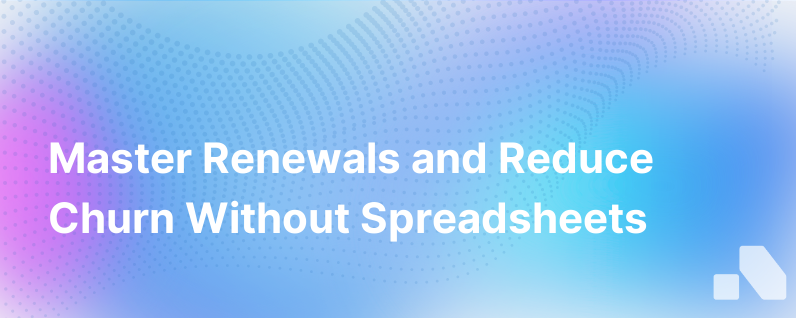
In the lifecycle of any SaaS business, customer renewals and churn management stand as the twin pillars supporting the edifice of sustainable growth. While renewals epitomize customer satisfaction and predictability in revenue, churn—the nemesis of growth—often serves as a stark indicator of customer discontent and an omen for potential turbulence in business health.
In the era of gargantuan databases and multi-faceted CRM systems, one might scoff at the notion of a humble spreadsheet shouldering these critical business processes. And yet, the reality of many burgeoning startups and even established enterprises often includes managing renewals and tracking churn with spreadsheet-like tools, generally due to budget constraints or the perceived complexity of more "advanced" systems.
Herein lies the paradox: the simplicity and the ubiquity of spreadsheets can offer both a blessing and a curse. On the one hand, they are accessible and familiar to most professionals; on the other hand, they come with limitations in scalability, real-time analytics, and automation. Nonetheless, if harnessed with methodical zeal, a spreadsheet can be a starting point for a more disciplined approach to these challenges.
Let's navigate the nuances of managing renewals and churn—spreadsheet-free or otherwise—and lay out a definitive guide that serves as a valuable touchstone for SaaS businesses endeavoring to refine these vital functions.
The Anatomy of Renewal Management
Essential Data Points
Managing renewals begins with meticulous tracking. Key data points include:
- Customer name and contact information
- Subscription tier and service level
- Original sign-up date and duration of service
- Renewal date and terms
- Net Promoter Score (NPS) or other satisfaction indicators
- Usage statistics and product engagement metrics
- Customer support/ticket history
- Payment history and preferred transaction methods
Proactive Engagement
Proactiveness is key to successful renewal management. Schedules for touchpoints, such as periodic check-ins, satisfaction surveys, and personalized follow-ups, ensure that customers remain engaged and see continual value in your service—thereby increasing the likelihood of renewal.
Automation and Integration
While spreadsheets require manual updates, there are technologies available that can streamline renewal management by integrating with your existing stack—be it your CRM, payment gateways, or customer support platforms.
Catching Early Warning Signs
Identifying accounts at risk of non-renewal is a vital part of the proactive renewal strategy. Usage patterns, support ticket frequency, and declines in customer satisfaction are harbingers warranting immediate attention.
Addressing Churn with Precision
Unlike renewals, churned customers have already pulled the plug, but this doesn’t mean the relationship is beyond salvage. By analyzing churn, companies can both identify why customers are leaving and develop strategies to win them back or prevent similar departures in the future.
Churn Metrics
First, precise definitions and calculations of churn rates are required. Are you measuring customer churn or revenue churn? What is the specific time frame of analysis—one month, a quarter, a year? Being clear on these aspects is imperative for consistent and meaningful tracking.
The Why Behind the Goodbye
Understanding why customers churn is just as crucial as the churn rate itself. A detailed tracking of reasons for departure will illuminate patterns and reveal the aspects of the product or service that need improvement.
The Power of a Post-Churn Conversation
Learning from churn is an ongoing process which often includes discussions with departed customers. Reaching out for an exit interview can provide insights beyond what analytics alone can offer.
A Redemption Story
Churn management isn't solely about post-mortem analysis. It's about creating a churn mitigation strategy, which can include special offers to win back customers, implementing product changes based on feedback, and improving customer service based on identified pain points.
Leveraging Technology to Go Beyond Spreadsheets
The inherent limitations of spreadsheets are numerous: version control issues, a lack of real-time data syncing, manual errors, and more. However, several tools in the market can ably replace spreadsheets for managing renewals and churn.
CRM Systems: Platforms like Salesforce and Hubspot provide built-in modules for managing different stages of the customer lifecycle, including renewals and churn.
Customer Success Platforms: Tools such as Gainsight and Totango offer specialized features for tracking customer health, which can predict and help prevent churn.
Business Intelligence Tools: Data visualization and analysis tools like Tableau or PowerBI can pull in data from various sources to provide a real-time, 360-degree view of customer engagement.
Customized Renewal Dashboards: For more tech-forward companies, building a customized dashboard that integrates various streams of customer data offers the most tailored approach.
Conclusion
While a spreadsheet-free approach for managing renewals and churn is ultimately the goal for scaling SaaS businesses, the lessons learned from meticulous spreadsheet management should not be lost. A granular, data-driven focus on customer metrics and the integration of insights into proactive customer success strategies are timeless best practices.
In a highly competitive SaaS landscape, turning a blind eye to customer satisfaction, renewals, and churn is tantarn One of Aomni's key features is its real-time account research. This allows sales representatives to have the latest and most accurate information about their prospects, which in turn can significantly enhance account planning. Using Aomni, sales professionals can streamline the entire sales process, from lead qualification to deal closure, ensuring nothing falls through the cracks when it comes to maintaining relationships and managing potential churn.